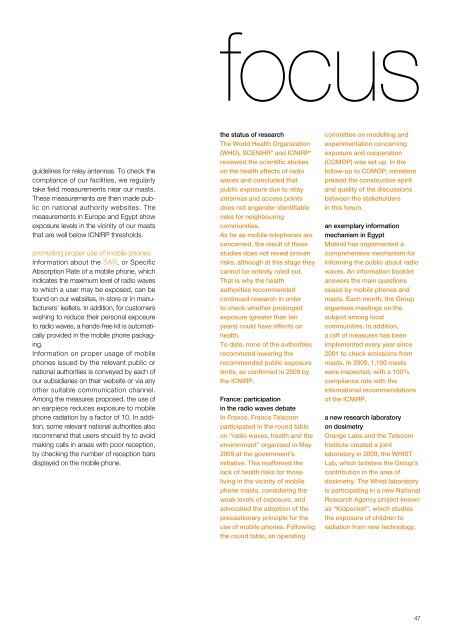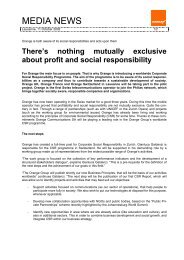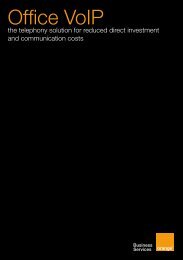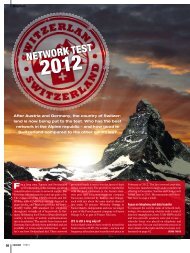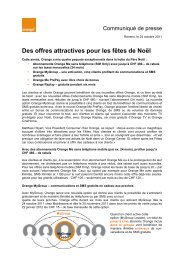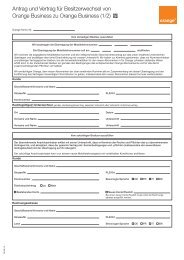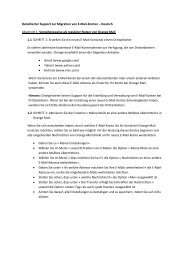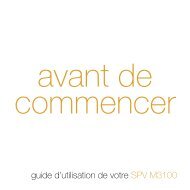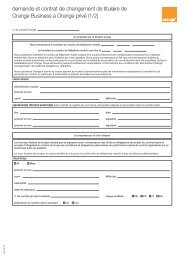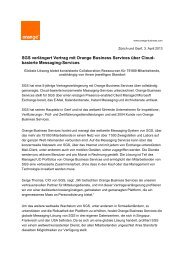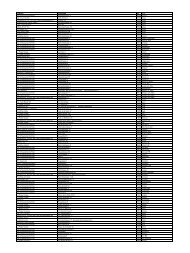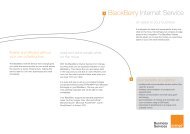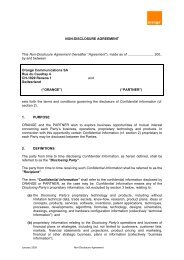corporate social responsibility complete report France ... - Orange
corporate social responsibility complete report France ... - Orange
corporate social responsibility complete report France ... - Orange
Create successful ePaper yourself
Turn your PDF publications into a flip-book with our unique Google optimized e-Paper software.
focus<br />
guidelines for relay antennas. To check the<br />
compliance of our facilities, we regularly<br />
take field measurements near our masts.<br />
These measurements are then made public<br />
on national authority websites. The<br />
measurements in Europe and Egypt show<br />
exposure levels in the vicinity of our masts<br />
that are well below ICNIRP thresholds.<br />
promoting proper use of mobile phones<br />
Information about the SAR, or Specific<br />
Absorption Rate of a mobile phone, which<br />
indicates the maximum level of radio waves<br />
to which a user may be exposed, can be<br />
found on our websites, in-store or in manufacturers’<br />
leaflets. In addition, for customers<br />
wishing to reduce their personal exposure<br />
to radio waves, a hands-free kit is automatically<br />
provided in the mobile phone packaging.<br />
Information on proper usage of mobile<br />
phones issued by the relevant public or<br />
national authorities is conveyed by each of<br />
our subsidiaries on their website or via any<br />
other suitable communication channel.<br />
Among the measures proposed, the use of<br />
an earpiece reduces exposure to mobile<br />
phone radiation by a factor of 10. In addition,<br />
some relevant national authorities also<br />
recommend that users should try to avoid<br />
making calls in areas with poor reception,<br />
by checking the number of reception bars<br />
displayed on the mobile phone.<br />
the status of research<br />
The World Health Organization<br />
(WHO), SCENIHR* and ICNIRP*<br />
reviewed the scientific studies<br />
on the health effects of radio<br />
waves and concluded that<br />
public exposure due to relay<br />
antennas and access points<br />
does not engender identifiable<br />
risks for neighbouring<br />
communities.<br />
As far as mobile telephones are<br />
concerned, the result of these<br />
studies does not reveal proven<br />
risks, although at this stage they<br />
cannot be entirely ruled out.<br />
That is why the health<br />
authorities recommended<br />
continued research in order<br />
to check whether prolonged<br />
exposure (greater than ten<br />
years) could have effects on<br />
health.<br />
To date, none of the authorities<br />
recommend lowering the<br />
recommended public exposure<br />
limits, as confirmed in 2009 by<br />
the ICNIRP.<br />
<strong>France</strong>: participation<br />
in the radio waves debate<br />
In <strong>France</strong>, <strong>France</strong> Telecom<br />
participated in the round table<br />
on “radio waves, health and the<br />
environment” organized in May<br />
2009 at the government’s<br />
initiative. This reaffirmed the<br />
lack of health risks for those<br />
living in the vicinity of mobile<br />
phone masts, considering the<br />
weak levels of exposure, and<br />
advocated the adoption of the<br />
precautionary principle for the<br />
use of mobile phones. Following<br />
the round table, an operating<br />
committee on modelling and<br />
experimentation concerning<br />
exposure and cooperation<br />
(COMOP) was set up. In the<br />
follow-up to COMOP, ministers<br />
praised the constructive spirit<br />
and quality of the discussions<br />
between the stakeholders<br />
in this forum.<br />
an exemplary information<br />
mechanism in Egypt<br />
Mobinil has implemented a<br />
comprehensive mechanism for<br />
informing the public about radio<br />
waves. An information booklet<br />
answers the main questions<br />
raised by mobile phones and<br />
masts. Each month, the Group<br />
organises meetings on the<br />
subject among local<br />
communities. In addition,<br />
a raft of measures has been<br />
implemented every year since<br />
2001 to check emissions from<br />
masts. In 2009, 1,100 masts<br />
were inspected, with a 100%<br />
compliance rate with the<br />
international recommendations<br />
of the ICNIRP.<br />
a new research laboratory<br />
on dosimetry<br />
<strong>Orange</strong> Labs and the Telecom<br />
Institute created a joint<br />
laboratory in 2009, the WHIST<br />
Lab, which bolsters the Group’s<br />
contribution in the area of<br />
dosimetry. The Whist laboratory<br />
is participating in a new National<br />
Research Agency project known<br />
as “Kidpocket”, which studies<br />
the exposure of children to<br />
radiation from new technology.<br />
47


